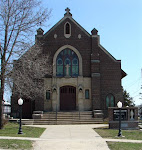Friday, October 16, 2009
Candlesticks on the Altar
Father,
What is the significance of the six candlesticks on the altar?
Thanks and God bless,
Laurette
Laurette,
The use of candles in the Roman liturgy is an ancient practice which reflects a theology of light central to Christianity. A world "darkened" by sin long awaited the light of God's revelation, first in the encounters in the Old Testament and later in the full revelation in Christ himself. We see this in the prayers of the Easter Vigil in which we proclaim, "Father, we share in the light of your glory through your Son, the light of the world." In addition, the lit candles in liturgical ceremonies are reminders of our baptism. In the baptismal ceremony a candle is lit and the celebrant proclaims, "receive the light of Christ." The custom of making liturgical candles from at least 51% beeswax is representative of the belief that all nature contributed to the worship of God. In the ancient world it was beleived that the queen reproduced without male fertilization, an appropriate analogy to the the Incarnation. On a more basic level candles also add to the enrichemnt, festivity and solemnity of the Sacred Liturgy. Traditionally, the number of candles lit was a reflection of the level of solemnity of the Mass. Two candles would be uses for daily Mass, four for feasts and solemnities and six for Sundays and solemnities. When a bishop celebrates Mass a seventh candle is used.
Fr. Pisut
Candlesticks on the AltarWhat is the significance of the six candlesticks on the altar?
Thanks and God bless,
Laurette
Laurette,
The use of candles in the Roman liturgy is an ancient practice which reflects a theology of light central to Christianity. A world "darkened" by sin long awaited the light of God's revelation, first in the encounters in the Old Testament and later in the full revelation in Christ himself. We see this in the prayers of the Easter Vigil in which we proclaim, "Father, we share in the light of your glory through your Son, the light of the world." In addition, the lit candles in liturgical ceremonies are reminders of our baptism. In the baptismal ceremony a candle is lit and the celebrant proclaims, "receive the light of Christ." The custom of making liturgical candles from at least 51% beeswax is representative of the belief that all nature contributed to the worship of God. In the ancient world it was beleived that the queen reproduced without male fertilization, an appropriate analogy to the the Incarnation. On a more basic level candles also add to the enrichemnt, festivity and solemnity of the Sacred Liturgy. Traditionally, the number of candles lit was a reflection of the level of solemnity of the Mass. Two candles would be uses for daily Mass, four for feasts and solemnities and six for Sundays and solemnities. When a bishop celebrates Mass a seventh candle is used.
Fr. Pisut


